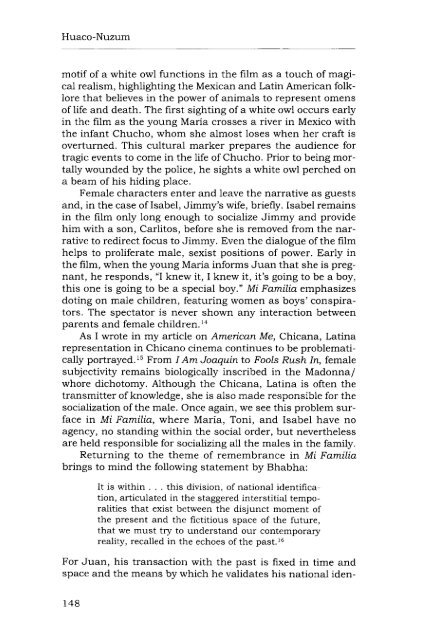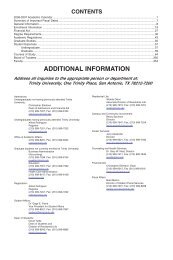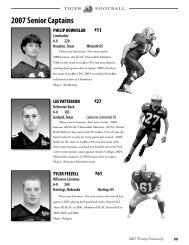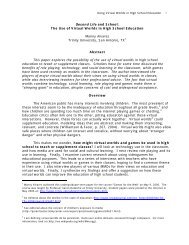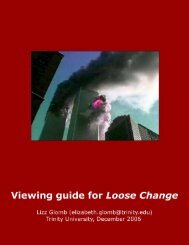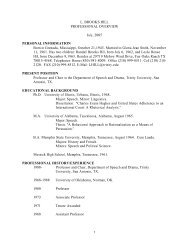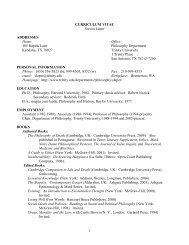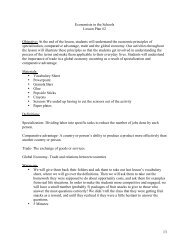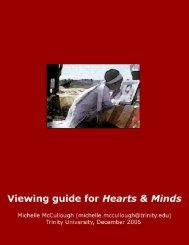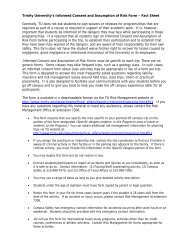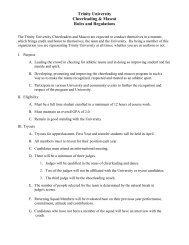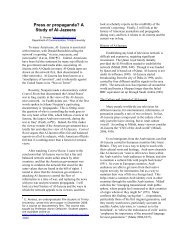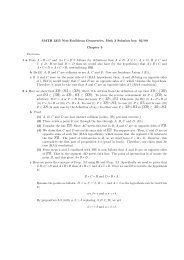Reviews - Trinity University
Reviews - Trinity University
Reviews - Trinity University
You also want an ePaper? Increase the reach of your titles
YUMPU automatically turns print PDFs into web optimized ePapers that Google loves.
Huaco-Nuzum<br />
motif of a white owl functions in the film as a touch of magical<br />
realism, highlighting the Mexican and Latin American folklore<br />
that believes in the power of animals to represent omens<br />
of life and death. The first sighting of a white owl occurs early<br />
in the film as the young Maria crosses a river in Mexico with<br />
the infant Chucho, whom she almost loses when her craft is<br />
overturned. This cultural marker prepares the audience for<br />
tragic events to come in the life of Chucho. Prior to being mortally<br />
wounded by the police, he sights a white owl perched on<br />
a beam of his hiding place.<br />
Female characters enter and leave the narrative as guests<br />
and, in the case of Isabel, Jimmy’s wife, briefly. Isabel remains<br />
in the film only long enough to socialize Jimmy and provide<br />
him with a son, Carlitos, before she is removed from the narrative<br />
to redirect focus to Jimmy. Even the dialogue of the film<br />
helps to proliferate male, sexist positions of power. Early in<br />
the film, when the young Maria informs Juan that she is pregnant,<br />
he responds, “I knew it, I knew it, it’s going to be a boy,<br />
this one is going to be a special boy.” Mi Familia emphasizes<br />
doting on male children, featuring women as boys’ conspirators.<br />
The spectator is never shown any interaction between<br />
parents and female children. l4<br />
As I wrote in my article on American Me, Chicana, Latina<br />
representation in Chicano cinema continues to be problematically<br />
portrayed.15 From IAm Joaquin to Fools Rush In, female<br />
subjectivity remains biologically inscribed in the Madonna/<br />
whore dichotomy. Although the Chicana, Latina is often the<br />
transmitter of knowledge, she is also made responsible for the<br />
socialization of the male. Once again, we see this problem surface<br />
in Mi Familia, where Maria, Toni, and Isabel have no<br />
agency, no standing within the social order, but nevertheless<br />
are held responsible for socializing all the males in the family.<br />
Returning to the theme of remembrance in Mi Familia<br />
brings to mind the following statement by Bhabha:<br />
It is within . . . this division, of national identification,<br />
articulated in the staggered interstitial temporalities<br />
that exist between the disjunct moment of<br />
the present and the fictitious space of the future,<br />
that we must try to understand our contemporary<br />
reality, recalled in the echoes of the past.16<br />
For Juan, his transaction with the past is fixed in time and<br />
space and the means by which he validates his national iden-<br />
148


